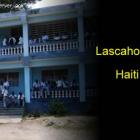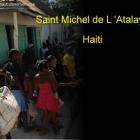ADVERTISEMENT
2010 Haiti earthquake - Haiti Observer Blog
2010 Haiti earthquake, Haiti Observer Blog. Read the following articles about 2010 Haiti earthquake
Prostitution in Haiti
There is a propensity to blame the rise of the most vice-like aspects of Haiti's current culture on the January 12, 2010 earthquake. Prostitution is one such vice often named consequence of the earthquake. The truth is, prostitution had already been a problem in the country, but had been quickly exacerbated by the loss of life and livelihood that the catastrophe caused.
Many children were left without parents after the earthquake. Not only did this rob them of their main source of sustenance, but they also suffered the loss of much needed guidance and the hope and insouciance to be gained from having parents to fend for them.
Institution du Sacre-Coeur Turgeau - Les Filles de la Sagesse
It has been a slow but eventual road to recovery for the sisters and students of the Institution du Sacré-Coeur de Turgeau. Ever since the January 2010 earthquake, which, in less than a minute, took down the old Sacred Heart in its entirety save for the gymnasium, the rebuilding process has been in progress. Now, the school can celebrate its brand new infrastructure, including the secondary school completed last year--with plans for three other modules to follow--, but there were many steps along the way to the restoration of the Institute of the Sacred-Heart.
Fatal Assistance - Assistance Mortelle by Hatian filmmaker Raoul Peck
Here is the documentary that you have heard so much about. Assistance Mortelle or Fatal Assistance in English was realized by Hatian filmmaker Raoul Peck. It is an exposé that provides a look at the response of the international community following the January 12, 2010 earthquake in Haiti. This film that made its World Premiere at the Berlin International Film Festival in February, has a duration of 1:45 minutes.
Se dokimantè ou te tande anpil pale sou li. "Asistans Mortelle" te reyalize pa Hatian sineast Raoul Peck. Se yon ekspoze ki bay yon gade sou tranbleman tè 12 janvye 2010 an Ayiti.
Rene Preval and the 2010 Earthquake
When the largest earthquake ever recorded in this part of the Caribbean, a 7.0 magnitude behemoth that created more devastation than any other quake in the past 200 years of Haiti's history, struck, President René Préval was, like most Haitians on the January 2010 evening, hoping for a prosperous end to their day. Just before 5pm the earthquake struck and hours later, the death toll was astronomical, the devastation of local aid facilities almost total and the need for leadership paramount.
Criticized for the lack of representation some feel they experienced after the earthquake, Rene Preval made few statement to the press directly following the catastrophe. One such comment, to the Miami Herald, was filled with generalized reports of the devastation with him stating, 'There are a lot of schools that have a lot of dead people in them', and his estimation that thousands had perished.
Leogane, The 2010 Earthquake's Epicenter
One town that felt the full blow of the 2010 earthquake in Haiti is Leogane, which is located in Ouest Department. This seaside town was the epicenter of the devastating 7-magnitude earthquake that killed tens of thousands of people. Between 20,000 and 30,000 people were reported dead in the town when the tremor rattled it on January 12, 2010.
The number of casualties is not the only mark of devastation that the disaster left in Leogane. A United Nations assessment also found out that up to 90% of buildings in the town were damaged, making it the worst affected area. The damage it received from the disaster was greater than that in the capital of Port-au-Prince. The Sainte Rose de Lima School, which is considered the heart of the city, was destroyed. As well as other important buildings such as the Saint Croix Hospital and the commercial strip the Grand Rue.
The Town of Cabaret and its Challenges
Life has not been easy for people living in Cabaret, which is one of the two towns forming the Arrondissement of Arcahaie in the Ouest Department. About 63,450 people are residing in the town and for the past years, they have faced a lot of challenges, including deaths and calamities.
In 2010, Haiti has been hit by a devastating earthquake that killed tens of thousands of people. In relation with this, Cabaret has witnessed the deadly impact of the calamity as it served as mass graves for the victims. Outside Titanyen, which is one of the settlements in Cabaret, mass graves were dug for the victims of the earthquake. Some parts of the fields were chosen so as to have a place to lay the victims to rest.
Croix Des Bouquets and The 2010 Earthquake impact
The residential town of Croix Des Bouquets in the Ouest Department used to be clean, peaceful and glamorous. Even if a deadly earthquake rattled the entire country in 2010, Croix Des Bouquets retained its glamour as it was not as affected as the capital of Port-au-Prince. However, the aftermath of the earthquake eventually became destructive and detrimental to Croix Des Bouquets.
As survivors fled Port-au-Prince to seek shelter in other towns and cities, refugees thronged to Croix Des Bouquets. This resulted in a period of chaos, as people continued to come to the town. People began setting up tents for shelters and merchants started to scatter all around. This made the town untidy and unruly, which was such a waste because a lot of developmental programs have been done in the area to keep it clean, peaceful and orderly.
Impact of Haiti Earthquake Still Felt After Three Years
Three years after Haiti's earthquake shattered the country's infrastructure, little has happened in recovery efforts. Immediately following the quake, the population of Port-au-Prince slept on streets, sidewalks, their autos, or jerry-built hovels. Thousands of bodies lay decomposing in the open air with rising levels of putrefaction. Delays in aid distribution caused random outbreaks of violence and survivors retaliated.
Please click here for more pictures of the 2010 Haiti Earthquake....
Destruction of Port-au-Prince and the regions' historical and government buildings were demolished or heavily damaged. Ruination of Haiti's infrastructure has added up $8 billion. Even though the country received $9 billion in aid, less than 10% has been spent in rebuilding localities. Recovery funds have been misspent in the millions due to not prioritizing urgent and wide-scale improvements needed. A result of this shows at least 500,000 quake survivors still living in tent cities in Port-au-Prince.
Canada to stop funding new aid projects in Haiti, said Julian Fantino
We just learned that the International Co-operation Minister in Canada, Julian Fantino, made a shocking announcement regarding Haiti. During an interview in Motreal, he said that he was disappointed at what he considered the lack of progress in Haiti during his November visit.
"Canada will stop funding new aid projects in Haiti until Ottawa finds a better way for Haiti to help itself", said Julian Fantino
There goes the majority of our annual budget
According to the Canadian official, Canada has been one of the biggest donors to Haiti, delivering $1 billion in development cash to the island nation since 2006. He promised to continue to fund programs in Haiti that are in progress, but no new ones.
Haitian Firms get One Percent of $1 Billion-Plus Reconstruction Funds
Center for Economic and Policy Research (CEPR) released a report that of $1.15 billion donated to Haiti post the earthquake, only one percent was received by Haitian firms, $1.15 million. The bulk of pledges was delivered to American-based corporations.
CEPR says it's impossible to find out where all the monies went. The problem is not who the main beneficiaries are, but where they are administering funds. For example, how much is spent on capital expenditures, administrative costs, transportation, and living allowances? And what amount has gone to Haiti's infrastructure?
United States Inter-Agency Development (USAID) organization, global disburser of monies, has refused comment on improprieties CEPR's report has hinted at. It has not offered any explanation why Haitian firms have received such a small share of funding, while Chemonics International Inc. (CII) has disproportionately been given $680 million in the last year. CII is the biggest beneficiary of USAID monies globally. Its $196-million share over the last three years outstrips combined totals of the second, third, and fourth beneficiaries on the disbursement list.
Our objective is to share with you news and information about Haiti and the people of Haiti. Traditions, habits and the way we were or grew are alive in this site. We highly recommend that you Subscribe to our Newsletter and also share with us some of the things that are memorable and made us unique people.

 Thomonde, Haiti
Thomonde, Haiti  Lascahobas, Haiti
Lascahobas, Haiti  Haitians are a Proud People
Haitians are a Proud People  Saint Michel de L 'Atalaye
Saint Michel de L 'Atalaye  Life After Death
Life After Death